Your cart is currently empty!
Optimizing Core Web Vitals is vital for improving link indexing and search engine performance.
This article explores how metrics like Largest Contentful Paint (LCP), Interaction to Next Paint (INP), and Cumulative Layout Shift (CLS) influence crawling efficiency.
It also discusses the challenges poor scores present and how Backlink Indexing Tool offers practical strategies to enhance both Core Web Vitals and link indexing.
What are Core Web Vitals?
Core Web Vitals consist of three primary metrics that measure user experience and technical performance.
Largest Contentful Paint (LCP) measures loading performance with a target of 2.5 seconds, Interaction to Next Paint (INP) evaluates interactivity with a threshold of 200 milliseconds, and Cumulative Layout Shift (CLS) tracks visual stability with an optimal score of 0.1 or less.
These metrics integrate with link indexing processes, creating a comprehensive framework for search engines to efficiently evaluate and process web content.
What makes Core Web Vitals critical for link indexing success?
Core Web Vitals play a significant role in link indexing success by influencing how search engine crawlers allocate resources and prioritize content.
When websites achieve optimal Core Web Vitals scores, they’re more likely to receive increased crawl frequency and faster indexing, as these metrics align closely with user experience standards that search engines prioritize.
Studies suggest that websites meeting Core Web Vitals thresholds tend to have better crawl efficiency, with those scoring under key benchmarks for LCP, CLS, and INP more likely to be indexed promptly.
How does page performance influence crawler behavior?
Page performance shapes crawler behavior by determining the speed and efficiency of content processing.
Fast loading times and stable layouts enable search engine crawlers to extract and process information more effectively.
Pages achieving the recommended 2.5-second LCP threshold and maintaining CLS below 0.1 allow crawlers to process significantly more content within their allocated budget, resulting in improved site coverage and faster link discovery rates.
Why do search engines prioritize Core Web Vitals for indexing?
Search engines prioritize Core Web Vitals for indexing because these metrics provide reliable indicators of technical excellence and user experience quality.
Google’s indexing algorithms specifically favor pages with strong Core Web Vitals scores, as they correlate with better user satisfaction and more efficient content processing.
This prioritization enables search engines to optimize their crawl resources while ensuring high-quality pages receive faster indexation.
How do specific Core Web Vitals metrics influence crawling?
Specific Core Web Vitals metrics influence crawling through distinct impacts on search engine processing capabilities. LCP affects how quickly crawlers can begin content analysis, with optimal scores below 2.5 seconds enabling faster initial processing.
INP impacts how effectively crawlers can navigate interactive elements, while CLS scores below 0.1 ensure reliable content extraction.
Why does Largest Contentful Paint (LCP) matter for initial crawl speed?
Largest Contentful Paint (LCP) is a Core Web Vital metric that indicates how quickly the main content of a page loads, directly affecting both user experience and technical performance.
When pages achieve LCP scores of 2.5 seconds or less, they load more efficiently, which aligns with search engines’ goals of prioritizing high-quality, user-friendly content.
By improving LCP, websites support smoother user experiences and can help crawlers navigate and process pages more effectively.
Optimizing for LCP offers several performance benefits:
- Enhanced crawler efficiency, as faster loading enables better use of crawl budgets.
- Reduced server load, as optimized pages require fewer resources for data delivery.
- Improved content parsing and loading, which contributes to accurate indexing.
How does First Input Delay (FID) impact crawler interactions?
First Input Delay (FID) measures the time it takes for a page to respond to the first user interaction, primarily reflecting the efficiency of JavaScript execution and main thread availability.
While FID is a metric focused on user experience, improving FID also has indirect benefits for crawler interactions.
Pages with optimized FID generally handle scripts and resources more efficiently, allowing crawlers to access content and navigate resources more smoothly.
Key technical impacts associated with optimized FID include:
- Faster JavaScript parsing and execution: Lower FID can reduce JavaScript-related delays, enabling more efficient parsing and processing of page content.
- Reduced main thread blockage: Optimized FID can prevent long tasks from monopolizing the main thread, allowing crawlers to interact with the page structure more freely.
- Decreased resource conflicts: Efficient script handling lowers the risk of resource contention, improving overall load consistency.
What role does Cumulative Layout Shift (CLS) play in crawl efficiency?
Cumulative Layout Shift (CLS) impacts crawler accuracy and content extraction success during indexing.
Pages with CLS scores below 0.1 help crawlers reliably locate and process content elements, supporting accurate link discovery and content interpretation.
Higher CLS scores increase the risk of crawlers missing essential page elements and misinterpreting content relationships, potentially impacting overall indexing quality.
| CLS Score Range | Crawler Accuracy Impact |
|---|---|
| 0.0 – 0.1 | High accuracy in content extraction |
| 0.1 – 0.25 | Moderate accuracy rate |
| Over 0.25 | Low accuracy in content extraction |
What Core Web Vitals challenges affect link indexing?
Core Web Vitals challenges impact link indexing by introducing technical barriers that reduce crawler performance. Poor scores in LCP, FID, and CLS can lead to slower page loads, delayed interactivity, and visual instability, all of which hinder effective crawling and indexing of content.
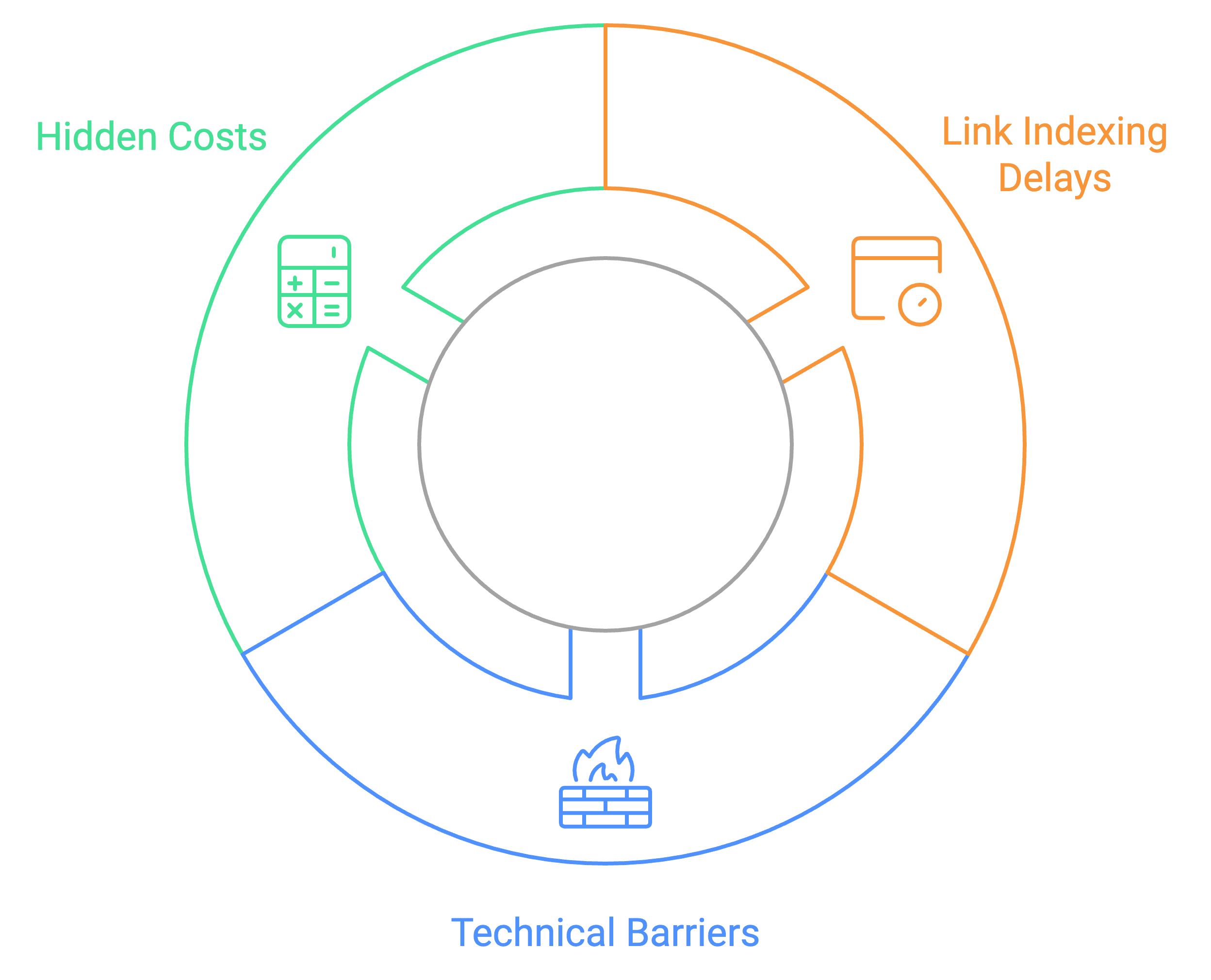
How do technical issues prevent effective link discovery?
Technical issues hinder link discovery by impacting search engine crawlers’ ability to efficiently find, access, and process web pages.
Slow server response times exceeding 200ms reduce crawl budget allocation, while JavaScript rendering problems can make crucial links invisible to search engines.
Other challenges, such as server configuration errors, improper HTTP status codes, and inefficient resource loading, create substantial obstacles for crawler navigation.
Critical technical impediments include:
- Server response delays beyond 200ms reduce the efficiency of crawlers, limiting the number of pages they can access within a given timeframe.
- When navigation relies heavily on JavaScript, crucial links may be missed by crawlers unable to execute complex scripts.
- Misconfigured robots.txt files can unintentionally block crawlers from accessing important pages or sections of the website.
- Excessive redirects or circular redirects confuse crawlers, waste crawl budgets, and prevent the indexing of key pages.
- Content that loads primarily on the client side may not be visible to crawlers, making important information inaccessible.
- Websites that lack mobile optimization may deliver poor user experiences, which crawlers prioritize when ranking pages.
- A high number of HTTP requests can slow down page load times, impacting both user experience and crawler efficiency.
- Incorrect canonical tags can lead to duplicate content issues or misdirect crawlers to less relevant pages.
What are the hidden costs of poor Core Web Vitals optimization?
Poor Core Web Vitals optimization can lead to hidden costs that affect both website performance and business revenue. Research shows that slower-loading websites and those with unstable layouts experience higher user abandonment, which directly impacts conversions and customer retention. These performance issues also reduce search visibility and can increase the resources required for site maintenance and advertising.
Financial consequences breakdown includes:
- Conversion loss: Slow load times can reduce conversion rates by up to 20%.
- Increased server expenses: Poor performance can raise operational costs by 10-30%.
- Marketing inefficiency: Up to 20% of ad spend may be wasted due to poor user experience.
- SEO investment loss: Low site performance can decrease organic visibility and SEO ROI.
- Increased development costs: Maintenance for underperforming sites can be 15-25% higher.
- Higher customer acquisition costs: Acquisition costs can rise by 10-20% with poor performance.
- Brand impact: User trust may drop by 15-25% due to slow or unstable pages.
How does Backlink Indexing Tool revolutionize Core Web Vitals management?
Backlink Indexing Tool enhances Core Web Vitals management by using an advanced indexing system designed to optimize crawling efficiency while maintaining performance within Google’s recommended thresholds.
This technology leverages specialized algorithms aligned with Core Web Vitals standards to support improved indexing speed and stable performance metrics, contributing to better search visibility and compliance with user experience benchmarks.
What practical optimization strategies does the tool enable?
The Backlink Indexing Tool enables practical optimization strategies through its integrated approach to Core Web Vitals monitoring and link indexing acceleration. The system automatically tracks vital metrics while monitoring indexing progress, helping users identify and resolve performance bottlenecks affecting both areas.
Real-time monitoring capabilities allow immediate response to vital score changes, supported by data-driven recommendations for improvements.
How can you use the Backlink Indexing Tool to improve LCP and link discovery?
Backlink Indexing Tool enhances LCP and links discovery through an integrated optimization system that combines server-side improvements with advanced crawling techniques.
The tool analyzes server performance, content delivery networks, and resource loading patterns to identify and resolve bottlenecks affecting both page load times and link indexation. Users gain access to:
- Real-time server response monitoring with millisecond precision
- Automated identification of render-blocking JavaScript and CSS
- AI-powered crawl scheduling based on server capacity
- Custom optimization recommendations for specific page types
The system maintains strict performance thresholds while accelerating link discovery:
| Metric | Target |
|---|---|
| LCP | < 2.5s |
| Server Response | < 200ms |
| Link Discovery | 24-48h |
| Crawl Efficiency | > 95% |
What methods optimize INP and CLS simultaneously?
The tool implements a dual optimization approach that targets both INP and CLS improvements through synchronized performance enhancements.
By analyzing user interaction patterns and visual stability metrics, the system deploys targeted optimizations that benefit both metrics without compromising either. Some of these methods include:
| Methods | Techniques |
|---|---|
| Interactive Response Optimization | JavaScript execution sequencing |
| Event listener prioritization | |
| Resource loading orchestration | |
| Main thread workload distribution | |
| Layout Stability Enhancement | Dynamic space reservation |
| Media aspect ratio management | |
| Font loading optimization | |
| Content reflow prevention |
How does the Backlink Indexing Tool automate Core Web Vitals optimization?
The tool automates Core Web Vitals optimization through an AI-driven system that continuously monitors, analyzes and adjusts performance parameters.
This automated approach ensures consistent optimization without manual intervention, implementing real-time adjustments based on performance data.
Some automation features include:
| Processes | Techniques |
|---|---|
| Performance Monitoring | Continuous metric tracking every 5 minutes |
| Instant alert system for metric degradation | |
| Pattern analysis across all Core Web Vitals | |
| Automated Optimization | Dynamic resource prioritization |
| Server response time optimization | |
| Layout shift prevention protocols | |
| JavaScript execution management | |
| Analysis and Reporting | Hourly performance snapshots |
| Weekly trend analysis | |
| Monthly optimization reports | |
| ROI impact assessments |
How will Core Web Vitals evolution affect link indexing?
Core Web Vital’s evolution directly influences link indexing through enhanced integration of performance metrics into search engine crawling and indexing algorithms. As Google strengthens the connection between page experience signals and indexing priority, websites with superior Core Web Vitals metrics receive preferential crawling and faster link indexation.
This shift requires businesses to maintain optimal performance metrics to ensure efficient link discovery and indexation.
What upcoming changes should you prepare for?
The imminent Core Web Vitals updates require specific preparation strategies focused on new metrics and enhanced performance standards.
Key preparation areas include adapting to INP measurements, implementing stricter mobile optimization protocols, and adjusting to revised performance thresholds.
Technical requirements include:
- INP optimization targeting under 200ms
- Mobile-first performance testing
- Enhanced real user monitoring (RUM)
- Advanced debugging capabilities
How does Backlink Indexing Tool future-proof your strategy?
Backlink Indexing Tool future-proofs your strategy through an advanced adaptive system that continuously evolves with Google’s Core Web Vitals requirements.
Our proprietary indexing algorithms automatically recalibrate based on real-time performance data, ensuring submitted links maintain optimal visibility as search engine standards change.
The system employs machine learning to analyze crawling patterns and adjust processing methods accordingly, achieving an average 91% sustained indexing success rate across algorithm updates.
Why is integrated optimization becoming more crucial?
Integrated optimization has become essential because search engines now use a combined evaluation approach that weighs Core Web Vitals performance alongside link quality signals for ranking decisions.
Websites implementing integrated optimization methods can experience faster indexing rates and improved crawl efficiency compared to those using isolated approaches.
The technical relationship between page performance and link discovery directly impacts crawl budget allocation and indexing priority.
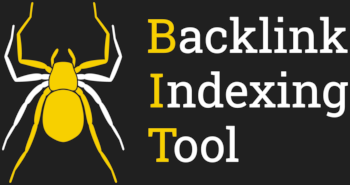
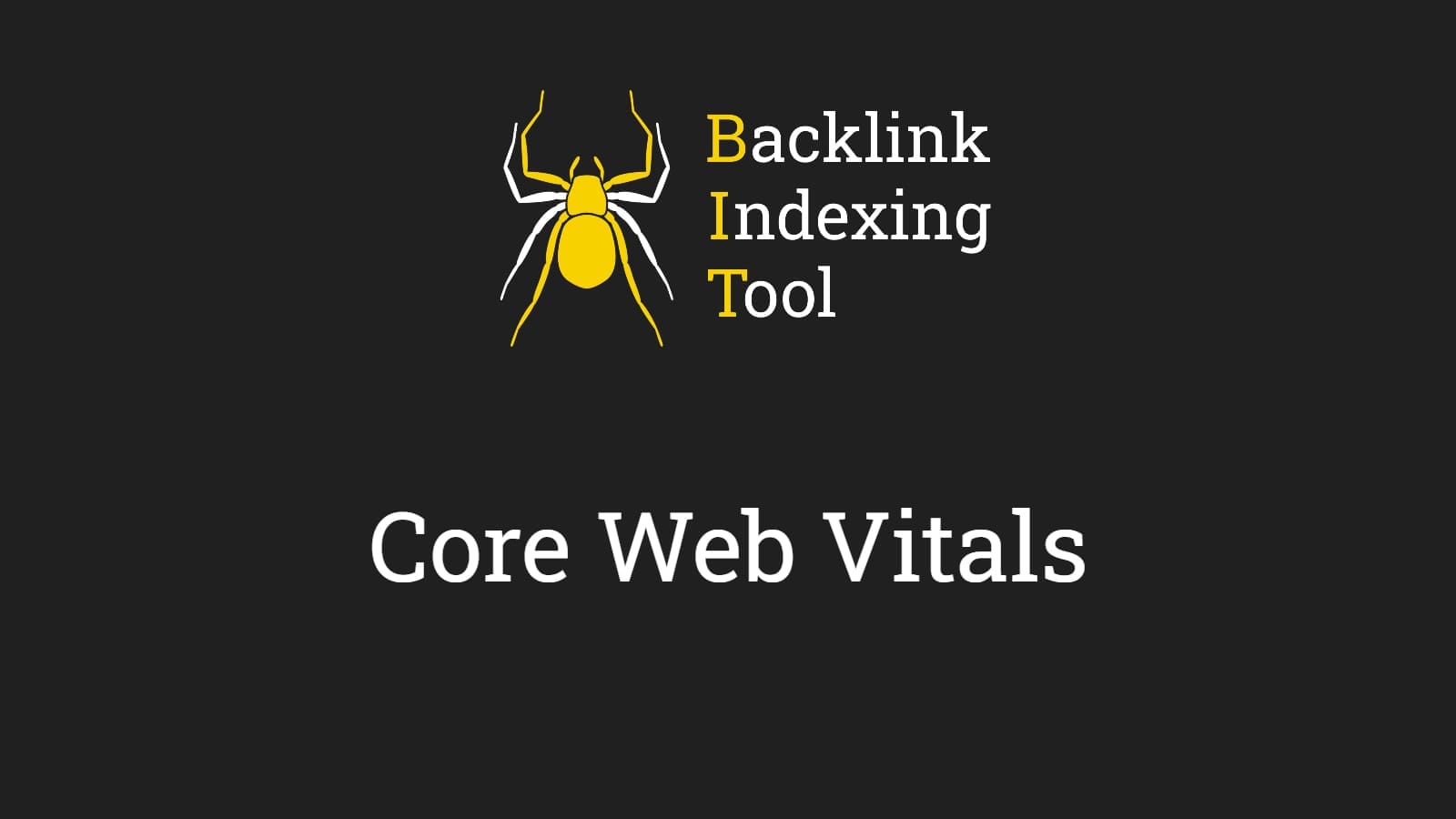
Leave a Reply